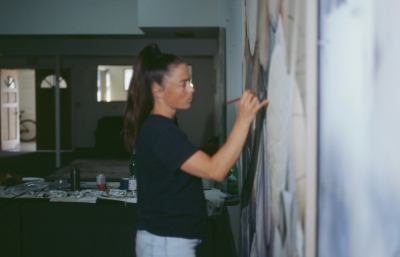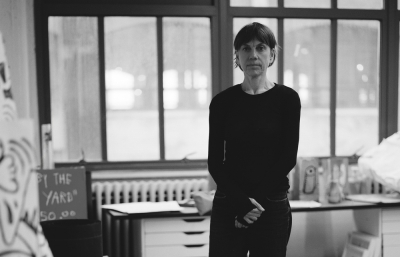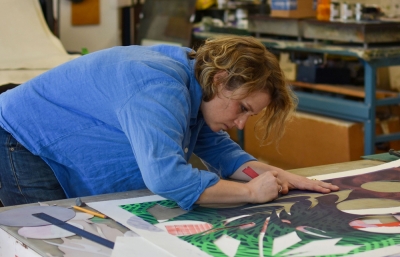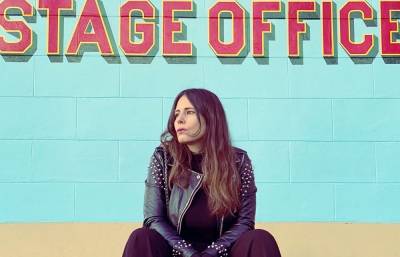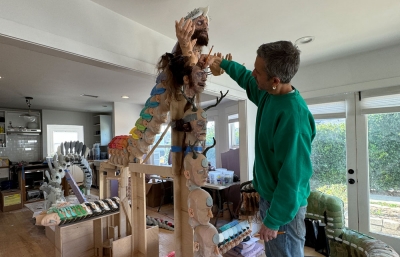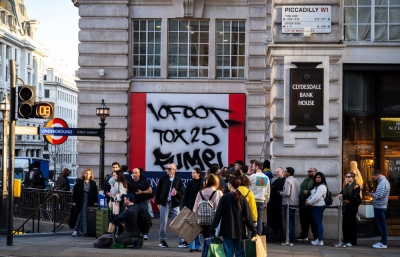Angela Anh Nguyen is a self-educated textile artist referencing colonial hypocrisy, death metal and a wild array of perspectives. She stays tough while tufting, broaching hardcore topics with soft materials. Her utilitarian, substantive rug art is imbued with a fierce objective and a dedicated hand. If any artist could be described by the old adage, “kicking ass and taking names,” Angela is the one.
Kristin Farr: Who do you make your art for?
Angela Anh Nguyen: For those who can’t have it.
Does your process involve a tufting gun, and how did rugs become your medium of choice?
I design my rugs by layering and collaging images, and I sketch in the typography. I project the rough designs onto my canvas, trace, and detail, then I tuft with the gun. I am one of the few hundred individuals who have surfaced from the renaissance of tufting. I started about three years ago after watching videos of tufting with a friend. I never considered myself much of an artist until artists within my community began to credit my work. I was working in restaurants before this, washing dishes, making drinks, bussing tables. I’d make rugs for myself at home, then I would drive to my job and clock in before I got laid off in March 2020. I used my Trump bucks from the pandemic to build a studio in my room, and moved my bed to the basement to sleep at the Chinatown house my friends and I rented. I started designing, collecting unemployment and throwing all that shit into making rugs. The pandemic hasn’t exactly aided in my ability to keep track of time, but it’s a new practice for me, and I am learning more and more about it every day. I’m completely self taught and I probably owe that to indecisiveness and impulsivity.
Some of your inspiration is clear—LA, the Dodgers, monster trucks and justice. What are other critical ingredients?
I try to incorporate working-class sentiments into everything I make. Everyday life, narratives of insignificance, public discourse on various topics. But also… irony, exaggeration, and hypocrisy. Things I can’t have and never had. I grew up in a household where my dad would constantly talk to my sister and me about anything related to foreign policy in the news. He was, and is, always glued to the TV— ESPN, CNN, MSNBC, The Hill, all that nonsense. I was 14 years old and he was talking to my sister and me about a US China tariff war, or reimplementing the gold standard in Greece. His habits of sports fandom and American politics have sort of followed me around, just in a different form, I guess.
Some of your work features deepcut facts, like Saved ‘Em. Tell me about Bigfoot the monster truck, as well as your pandemic heirloom, Virus!!!!
Monster trucks are funny. I was a pretty protected child when it came to the outside world. My parents censored a lot of stuff from me. I’m from Cerritos, a small town in SoCal, and they would have Monster Jam in Anaheim all the time. I always wanted to go. I saw it from the gate at a fair when I was younger. It was so sick. I just stood there for 30 minutes. People drinking Red Bull absolutely enthralled by a goddamn car with a dumb name doing flips and shit. Also, the trucks are always sponsored by the craziest brands and businesses. You’ll see a truck with a chef's hat and mustache sponsored by Sbarro. I find Monster Jam to be such a powerful event—ha ha! It’s significant in the most insignificant way. It’s ironic and exaggerated, and I think it makes a great base for the stories I want to tell in my work. These themes specifically influenced Virus!!!! and the depiction of a lockdown to those resistant.
Bigfoot is one of the older monster trucks that actually and legitimately looks like a Chevy pick-up. It felt so American to me, and I had an idea in mind about doing a piece on US imperialism after a back-and-forth I had with my dad some Sundays ago about the American presence in Vietnam. The image itself is the truck on top of a junkyard of cars. The text reads “SAVED ‘EM!,” an assumption of having saved all the cars, when they’ve all turned to trash because of Bigfoot. It's reflective of American intervention, which to no surprise, tends to be an embarrassment and failure to “democracy,” whether it be in Vietnam, Venezuela, Algeria, etc. It’s kind of funny when I put it in words.
How are cassette tapes and zines influential in your designs?
My partner Michael is a huge metal-head. He has over 1000 cassettes in this little apartment we share and schools me on everything I ever thought I knew about any genre of music. One of the first rugs I made was largely inspired by him and our discussions about the commercialization of metal iconography. Why would a bedroom pop artist make merch that looks like black metal typography? I thought it was so unusual, commercializing an aesthetic for no reason at all other than to sell something that looks hardcore. So I thought, “OK, fuck it, I wanna to do that too.” Michael taught me how to sketch metal typography after doing metal-inspired text for a few of my rugs. I look through his book METALION, which is over 700 pages of Slayer magazine issues or zines. There is so much incredible typography in that book, and reading through it has taught me so much about death metal culture. Darkthrone is iconic, but there are so many different and creative techniques of art and text in that book from unsigned and underrated metal artists.
Tell me about some of your custom commissions.
I worked on a commission recently that really inspired some pieces I worked on moving forward. My now friend Marcus wanted me to work on an adaptation of a stomp-out scene from the ’90s movie Don’t Be a Menace. I’ve worked on bodies before, but I think the concept of a flattened human felt a lot more animated and exaggerated and in-line with what I do.
I was surprised to see your work actually used as rugs in lucky people’s homes! I would definitely take my shoes off.
What is a rug that’s not on the floor? I would like my rugs to play the role of a rug. To be stepped on, aged with time, to tell stories and generate memories with their stains. A rug is something that lives with you, and if it is a rug of mine—hopefully, for a long time. Aside from that, shoes better come off!
Were there rugs or textile art you grew up with that might’ve been influential in the long run?
When it comes to rugs, I am largely influenced by the structure of gabbeh rugs, which are handmade, woven Persian rugs. They are usually woven with a set border, and inspire the structure of my rectangular pieces. I always have some sort of border to hug my images.
Angela is currently working with LA fashion brand Good Fight, and her work will also be on view with Albertz Benda, Los Angeles and the Dallas Art Fair this spring. This article first appeared in our Spring 2022 Quarterly.
Portrait by Wesley Banford






















